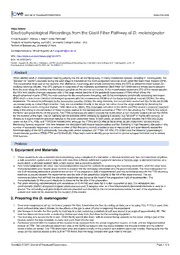
Electrophysiological Recordings from the Giant Fiber Pathway of D. melanogaster. PDF
Preview Electrophysiological Recordings from the Giant Fiber Pathway of D. melanogaster.
JournalofVisualizedExperiments www.jove.com VideoArticle Electrophysiological Recordings from the Giant Fiber Pathway of D. melanogaster Hrvoje Augustin1,MarcusJ. Allen2,Linda Partridge1 1InstituteofHealthyAgeing,andGEE,UniversityCollegeLondon-UCL 2SchoolofBiosciences,UniversityofKent Correspondenceto:[email protected] URL:http://www.jove.com/details.php?id=2412 DOI:10.3791/2412 Citation:Augustin H.,Allen M.J.,Partridge L.(2011).ElectrophysiologicalRecordingsfromtheGiantFiberPathwayofD.melanogaster.JoVE.47. http://www.jove.com/details.php?id=2412,doi:10.3791/2412 Abstract WhenstartledadultD.melanogasterreactbyjumpingintotheairandflyingaway.Inmanyinvertebratespecies,includingD.melanogaster,the "escape"(or"startle")responseduringtheadultstageismediatedbythemulti-componentneuronalcircuitcalledtheGiantFiberSystem(GFS). Thecomparativelargesizeoftheneurons,theirdistinctivemorphologyandsimpleconnectivitymaketheGFSanattractivemodelsystemfor studyingneuronalcircuitry.TheGFSpathwayiscomposedoftwobilaterallysymmetricalGiantFiber(GF)interneuronswhoseaxonsdescend fromthebrainalongthemidlineintothethoracicganglionviathecervicalconnective.Inthemesothoracicneuromere(T2)oftheventralganglia theGFsformelectro-chemicalsynapseswith1)thelargemedialdendriteoftheipsilateralmotorneuron(TTMn)whichdrivesthe tergotrochanteralmuscle(TTM),themainextensorforthemesothoracicfemur/leg,and2)thecontralateralperipherallysynapsinginterneuron (PSI)whichinturnformschemical(cholinergic)synapseswiththemotorneurons(DLMns)ofthedorsallongitudinalmuscles(DLMs),thewing depressors.Theneuronalpathway(s)tothedorsoventalmuscles(DVMs),thewingelevators,hasnotyetbeenworkedout(theDLMsandDVMs areknownjointlyasindirectflightmuscles-theyarenotattacheddirectlytothewings,butrathermovethewingsindirectlybydistortingthe nearbythoraciccuticle)(KingandWyman,1980;Allenetal.,2006).Thedi-synapticactivationoftheDLMs(viaPSI)causesasmallbutimportant delayinthetimingofthecontractionofthesemusclesrelativetothemonosynapticactivationofTTM(~0.5ms)allowingtheTTMstofirstextend thefemurandpropeltheflyofftheground.TheTTMssimultaneouslystretch-activatetheDLMswhichinturnmutuallystretch-activatetheDVMs forthedurationoftheflight.TheGFpathwaycanbeactivatedeitherindirectlybyapplyingasensory(e.g."air-puff"or"lights-off")stimulus,or directlybyasupra-thresholdelectricalstimulustothebrain(describedhere).Inbothcases,anactionpotentialreachestheTTMsandDLMs solelyviatheGFs,PSIs,andTTM/DLMmotoneurons,althoughtheTTMnsandDLMnsdohaveother,asyetunidentified,sensoryinputs. Measuring"latencyresponse"(thetimebetweenthestimulationandmuscledepolarization)andthe"followingtohighfrequencystimulation"(the numberofsuccessfulresponsestoacertainnumberofhighfrequencystimuli)providesawaytoreproduciblyandquantitativelyassessthe functionalstatusoftheGFScomponents,includingbothcentralsynapses(GF-TTMn,GF-PSI,PSI-DLMn)andthechemical(glutamatergic) neuromuscularjunctions(TTMn-TTMandDLMn-DLM).Ithasbeenusedtoidentifygenesinvolvedincentralsynapseformationandtoassess CNSfunction. Protocol 1. Equipment and Materials 1. Theseexperimentsuseastandardelectrophysiologysetupcomprisedofastimulator,astimulusisolationunit,twomicroelectrodeamplifiers, adataacquisitionsystemandacomputerwithcollectionsoftware.AdditionalequipmentincludesaFaradaycage,astereomicroscopeona boomstand,avibrationisolationtable,alightsource,andarecordingplatform. 2. Fivemicromanipulatorsareused.Twomicromanipulatorsrequirefinecontrolsforpositioningtherecordingelectrodes,whiletheotherthree micromanipulatorsonlyrequiregrosscontrolstopositionthetwostimulationelectrodesandthegroundelectrode.Themicromanipulatorfor theDLMrecordingelectrodeisplacedatthetailendofthepreparation(leftofexperimenter)andthemicromanipulatorfortheTTMrecording electrodeisplacedbetweentheexperimenterandthesideofthepreparation(slightlytotheleftoftheexperimenter).Thetwo micromanipulatorsthatwillholdthesimulationelectrodesareplacedattheheadofthepreparation(rightofexperimenter).The micromanipulatorforthegroundelectrodeisplacedatthefarsideofthepreparation 3. Pullglassrecordingmicroelectrodeswithresistancesof40-60MΩandstoreflatinadishsupportedbywax.Forstimulation,two electrolytically(NaOH)sharpenedtungstenelectrodesareused.Atungstenwire,orathirdelectrolyticallyfabricatedelectrodeisusedasa ground.Thestimulatingandgroundelectrodesarepreparedandattachedtothemicromanipulatorsbeforethestartoftheexperimental sessionandneednotbereplacedforthedurationofthesession. 2. Preparing the D. melanogaster 1. Onceyourequipmentissetup,it'stimetopreparetheflies.AnesthetizethefliesbycoolingonthemiceorbyusingCO2.IfCO2isused,then allowsufficienttime(about20mins)fortheeffectsofthegastowearoffpriortobeginningtheexperiment. 2. Useforcepstotransferthefliesgentlybytheirlegstoadishcontainingaplatformofsoftwaxslopedatanangleofapproximately45°.The nextfourstepsaredoneunderadissectingmicroscopeawayfrom(butcloseto)therecordingequipment. 3. Thenextstepistosecuretheflyinwax.Orienttheflyventralsidedown,withitsanteriorfacingupwardsontheslope.Usingapairoffine forceps,extendthelegsoutwards,inpairs,andpushthemintothewax. 4. Familiarizeyourselfwiththelocationofthemusclestoberecordedfrom:thedorsallongitudinalmuscle,orDLM,andthetergotrochanteral muscle,orTTM.ThesubcuticularattachmentsitesoftheDLMscorrespondwiththeregionbetweenthethoracicmidlineandtheanterior dorsalbristles(orsetae).TheTTMattachmentsitesarelocateddorsallyoftheposteriorandanteriorsupra-alarbristles.Makingsurethatthe wingswillnotobstructaccesstotheDLMorTTMfibers,holdthewingsoutwardand'glue'themtothewax. Copyright©2011JournalofVisualizedExperiments Page1of4 JournalofVisualizedExperiments www.jove.com 5. Usingafinepairofforceps,pulltheproboscisoutwardcarefully,andsecureitbyimmersingitintothewax.Thisisacriticalstepthatrequires somepracticesincetheproboscisissoftandiseasilydetachedfromtherestofthehead.Ifthathappens,discardtheflyandstartover. Failuretosecuretheheadinthiswayleadstoproblemswheninsertingthestimulatingelectrodesthroughtheeyes. 3. Placing the Electrodes 1. Oncetheflyisanchoredtothewax,transferthedishwiththeattachedflyunderneaththestereomicroscopethatislocatedinsidetheFaraday cage.Orienttheflysidewayswiththeheadoftheflytotherightoftheexperimenter. 2. Thenextstepistoinserttheelectrodes.Groundandstimulatingelectrodescanbeinsertedwithoutlookingthroughthemicroscope.Good recordingsrelyonpreciseimpalement,soitisagoodideatopracticehandlingthemicromanipulators.Bringtheelectrodesclosetothesites ofinsertionwiththehelpofmicromanipulatorstofacilitatetheirproperplacingandsubsequentrecordings. 3. Lowerthegroundelectrodeintotheposteriorendoftheabdomenusingtheadjustmentwheelsonthemicromanipulator.Toplacethe sharpenedtungstenstimulatingelectrodesinthebrain,usethemicromanipulatortopositionthetipofoneoftheelectrodessoitjusttouches oneoffly'seyes.Dothesamewiththeothersobothelectrodesarejusttouchingtheoutsideofeacheye.Thenpushtheelectrodes,inturn, througheacheyesothetipsoftheelectrodesreachthebrainsituatedatthebackoftheheadcapsule(about2-3mm). 4. CorrectlyplacedelectrodeswillactivatetheGiantFiberSystem.Totestthatthestimulatingelectrodesareplacedcorrectly,applyashort (0.03ms)stimulusof30-60Vacrossthestimulatingelectrodes,andlookformovementofthewingsandtwitchesoftheflight/legmuscle' 5. Thenextstepistoback-filltheglassmicroelectrodeswith3MKClusingaHamiltonorheat-pulledplasticsyringe,andplacethemintothe fine-controlmicromanipulators.Properlyinsertedmicroelectrodescanbeusedforseveralroundsofexperiments. 6. ThefirstrecordingelectrodewillbeinsertedintoaDLMfiber.TherearetwobilaterallysymmetricDLMs;eachoneiscomposedofsix individualmusclefibers.Therecordingscanbedonefromanyofthesixfibers;however,themostcommonlyusedareDLMfibers45aand 45bduetotheirgoodaccessibilitythroughthedorsalsideofthethoraciccuticle,andthefactthatbothfibersareinnervatedbythesame motorneuron. 7. Usingthemicromanipulatoronthesidefarthestfromyou,insertarecordingelectrodeintoDLMfiber45aorb.Theslopeoftheplatform allowstheDLMelectrodetoenterthedorsalcuticleata~60-90°angle,whichaidspenetration.Usethesoftwareinoscilloscopemodeand lookatthecomputermonitorwhileinsertingrecordingelectrodesintothethorax.Whentheelectrodehasenteredamusclethebaselinewill droptonearzerooranegativevalue.Testwithasinglestimulustoseeifyoucanobservethemuscleresponse. 8. InserttheotherrecordingelectrodeintotheTTMclosesttoyou.Thiselectrodeisinsertedlaterally,infrontofyou,duetothelocationofthe muscleattachmentsite.Againobservethemonitorwhiledoingthisandtestwithasinglestimulusoncethetraceindicatestheelectrodeisin themuscle. 4. Stimulation and Recording 1. Youarenowreadytobeginstimulatingthebrainandrecordingresponsesfromthelegandflightmuscles.Applyashort(0.03ms)stimulus acrossthestimulatingelectrodesstartingat30Vandincreasingto60Vuntilyouobservearesponse(i.e.amuscletwitch,andamusclecell depolarizationasobservedonthecomputermonitor).Fortheremainderoftheexperiment,setthevoltage5-10Vabovetheresponse threshold. 2. Tomeasureresponselatency,giveatleast5singlestimuliwitha5secondrestperiodbetweeneachstimulus. 3. Determinethe"frequencyoffollowing"byprovidingtrainsofstimuliatdifferentrates.Typically10trainsof10stimuliaregivenat100Hz (10msbetweeneachstimulus),200Hz(5msbetweeneachstimulus)and300Hz(3msbetweeneachstimulus).Allowarestperiodof2 secondsbetweeneachtrainofstimuli. 5. Results: Response Latencies and Frequency of Following in the Giant Fiber Pathway 1. Theresponselatencyisthetimebetweenstimulationofthebrainanddepolarizationofthemuscle.Thisfigurecomparestheresponse latenciesforDLMandTTMtoasinglestimulus.Latenciesbetween0.7and1.2msfortheGF-TTMpathwayandbetween1.3and1.7msfor theGF-DLMpathwayindicateahealthypreparationandproperrecordingtechnique.Thelatenciescanvarywithgenotype,genetic background,temperatureandage. Figure1(AandB).RepresentativetracesshowingresponsesrecordedfromtheTTMsandDLMsfollowingasinglestimulusappliedtothe brain. 2. Asshownhere,recordingsfromtheTTMshowmorevariabilityintermsofamplitudeandshapeofthepostsynapticpotential(PSP)compared tothosefromthelargeDLMfibers;thisincreasedvariabilityisduetothesmallsizeoftheTTMmusclefibers.Thisvariability,however,does notaffecttheresponselatencyvaluesfortheGiantFiber-to-TTMpathway. Figure1(CandD).Further'responselatency'tracesfrom4individualfliesforboththeTTMandDLM.NoteTTMtracesexhibitvariabilityin PSPshapebutresponselatencyisunaffected.ForDLMthereislessvariabilityinPSPshape. Copyright©2011JournalofVisualizedExperiments Page2of4 JournalofVisualizedExperiments www.jove.com 3. Comparethe"frequencyoffollowing"at100Hz,200Hz,and300Hzbycalculatingtheproportionofsuccessfulresponses(outof10)forboth DLMandTTMpathwaysateachstimulationfrequency.At100Hz,bothTTMandDLMfollowthestimuli1:1.Atstimulationfrequenciesabove 100Hz,theDLMresponsesstarttoshowfailuresbecausetheintermediarychemicalsynapsebetweentwointerneuronsdoesnothave sufficienttimetorecoverbetweenstimuli.TheTTMresponses,however,remain1:1withstimulievenbeyond300Hz. Figure2.Representativetracesshowingthe"frequencyoffollowing"recordings.At100Hz,bothTTMsandDLMsrespondtoall10stimuli (left).At200Hz,theDLMresponsesstarttofail(asterisk). 6. Representative Results Wildtypeshort-latencyresponses(stimulatedelectrodesareplacedintheeyes,bypassingsensoryreceptorsandtriggeringtheGFcircuit directly)dependongenotype,geneticbackground,temperatureandage,andrangebetween0.7and1.2msfortheGF-TTMpathwayand1.3 and1.7msfortheGF-DLMpathway(TanouyeandWyman,1980;ThomasandWyman,1984;EngelandWu,1992;AllenandMurphey,2007; Phelanetal.,2008;Augustinetal.,unpublished).ThisveryshortTTMlatencyisduetotherobustGF-TTMnelectrochemicalsynapseofthe monosynapticpathwayandthelongerDLMlatencyoccursbecauseofthedisynapticnatureofthepathwayaswellasthepresenceofachemical synapse(PSI-DLMn).Intermediate-andlong-latencyresponses(>3ms)resultfromtheactivationoftheGFafferentsandareachievedeitherby usingalowerintensitystimulationorprovidingavisual("light-off")signal.At100HzbothTTMandDLMshouldfollowthestimuli1:1.Above100Hz DLMresponseswillstarttoshowfailuresasthechemicalsynapsebetweenPSIandtheDLMnsdoesnothavesufficienttimetorecoverbetween stimulilessthan10msapart.TTMresponses,however,willremain1:1withstimulievenbeyond300Hz(TanouyeandWyman,1980;Engeland Wu,1992;Allenetal.,2007;Martinezetal.,2007).MutationsintheshakBgene,encodingaDrosophilagapjunctionchannel("innexin"), significantlyincreasetheresponselatencyoftheGF-TTMpathway(~1.5ms)whiletheGF-DLMbranchisunresponsive(AllenandMurphey, 2007;Phelanetal.,2008).Themutantresponsecanberestoredbystimulatingthoracicgangliadirectly,demonstratingthatthedelayedeffectis notduetodisruptedneuromusculartransmission.Theabilitytofollowhighfrequencystimulationisalsoimpairedinthesemutantscomparedto wildtypeflieswheretheGF-DLMandGF-TTMpathwaysareusuallyabletofollow10stimuliwith1:1ratioupto100Hzand300Hz,respectively. Itisimportanttonotethatthesefrequenciesareconsiderablyabovenormalstimulationfrequenciesreceivedbythecontractingmusclesduring thesustainedflight(3-10Hz)(HummonandCostello,1989). AnotherparameterusedtodescribethestabilityoftheGFSoutputsisthe"refractoryperiod",ortheminimaltimebetweentwinstimuluspulses thatstillproducestworesponsesfromthemuscle.Therefractorytimevariesbetween1-4msforTTMsand7-15msforDLMs.Thecomparatively longrefractoryperiodforDLMsisduetorelativelylabilechemicalsynapsesatthePSI-DLMnjunction(TanouyeandWyman,1980;Gorczycaand Hall,1984;EngelandWu,1992;Banerjeeetal.,2004;AllenandGodenschwege,2010). Copyright©2011JournalofVisualizedExperiments Page3of4 JournalofVisualizedExperiments www.jove.com Discussion Oneofthemostimportantthingsonehastopayattentiontowhentryingtoobtainhighqualityrecordingsistheproperorientationandhealthof thepreparation.Ideally,theflyshouldstillbealiveattheendoftherecordingsessionandresponsivetoelectricalstimuli.Fortherecording electrodestomostefficientlypenetratethethoracicexoskeleton,theflyshouldbegluedtothesurfaceinsuchawayastoformarightanglewith theelectrodes;ifnecessary,theinsertionofelectrodescanbefacilitatedbyremovingaportionofthedorsalthoraciccuticlewithatungsten scalpelthusexposingtheDLMflightmuscle(thisstepoffersanadditionaladvantageofmakingitharderforthetipsofglasselectrodestobreak). Also,thecaremustbetakentoavoidpushingtheelectrodesthroughthesubcuticularlylocatedDLMsandTTMs.Theheadoftheflyshouldbe wellsecuredtoallowforthestimulatingelectrodestobeproperlyinsertedintothebrainandtopreventthemfrombeingpulledoutduringthe recordingsession. Duetoitssizeandwell-describedmorphology,theGFSrepresentsoneofthemostaccessibleneuronalpathwaysinDrosophila.The permeabilityofelectricalsynapsestosmallmolecularweighttracerdyesallowsforthevisualisationofelectricallycoupledneurons,andseveral availableGAL4linesmakeitpossibletomanipulategeneexpressionlevelsinasubsetofcellsorcellgroups(Jacobsetal.,2000;Allenetal., 2006)Inadditiontotheabovementionedadvantages,bothafferentandthoraciccomponentsofthecircuitdisplaypropertiessuchashabituation, spontaneousrecoveryanddishabituation,makingtheDrosophilaGFSaconvenientmodelsystemforstudyingneuronalplasticity(EngelandWu, 1996). Disclosures Noconflictsofinterestdeclared. Acknowledgements ThisworkwassupportedbyaWellcomeTrustgranttoL.P. References 1. Allen,M.J.,Godenschwege,T.ElectrophysiologicalRecordingsfromtheDrosophilaGiantFiberSystem.In:BingZhang,MarcR.Freeman, ScottWadde,DrosophilaNeurobiology:ALaboratoryManual(1stLabed.),ColdSpringHarborPress,pp.(2010). 2. Allen,M.J.,Godenschwege,T.A.,etal.Makinganescape:developmentandfunctionoftheDrosophilagiantfibresystem.SeminCellDev Biol17(1):31-41(2006). 3. Allen,M.J.,andMurphey,R.K.ThechemicalcomponentofthemixedGF-TTMnsynapseinDrosophilamelanogasterusesacetylcholineas itsneurotransmitter."EurJNeurosci26(2):439-445(2007). 4. Banerjee,S.,Lee,J.etal.Lossofflightandassociatedneuronalrhythmicityininositol1,4,5-trisphosphatereceptormutantsofDrosophila.J Neurosci24(36):7869-7878(2004). 5. Engel,J.E.,andWu,C.F.Interactionsofmembraneexcitabilitymutationsaffectingpotassiumandsodiumcurrentsintheflightandgiant fiberescapesystemsofDrosophila.JCompPhysiolA171(1):93-104(1992). 6. Engel,J.E.,andWu,C.F.AlteredhabituationofanidentifiedescapecircuitinDrosophilamemorymutants.JNeurosci16(10):3486-3499. 7. Gorczyca,M.andHall,J.C.IdentificationofacholinergicsynapseinthegiantfiberpathwayofDrosophilausingconditionalmutationsof acetylcholinesynthesis.JNeurogenet1(4):289-313(1984). 8. Hummon,M.R.,andCostello,W.J.GiantfiberactivationofflightmusclesinDrosophila:asynchronyinlatencyofwingdepressorfibers.J Neurobiol20(6):593-602(1989). 9. Jacobs,K.,Todman,M.G.,etal.Synaptogenesisinthegiant-fibresystemofDrosophila:interactionofthegiantfibreanditsmajor motorneuronaltarget.Development127(23):5203-5212(2000). 10. King,D.G.,andWyman,R.J.AnatomyofthegiantfibrepathwayinDrosophila.I.Threethoraciccomponentsofthepathway.JNeurocytol 9(6):753-770(1980). 11. Martinez,V.G.,Javadi,C.S.,etal.Age-relatedchangesinclimbingbehaviorandneuralcircuitphysiologyinDrosophila.DevNeurobiol 67(6):778-791(2007). 12. Miller,A.TheinternalanatomyandhistologyoftheimagoofDrosophilamelanogaster.In:M.Demerec,Editor,BiologyofDrosophila(2nded.), (Hafner,NewYork)pp.502-503(1965). 13. Phelan,P.,Goulding,L.A.,etal.MolecularmechanismofrectificationatidentifiedelectricalsynapsesintheDrosophilagiantfibersystem. CurrBiol18(24):1955-1960(2008). 14. Power,M.E.Thethoracico-abdominalnervoussystemofanadultinsect,Drosophilamelanogaster.JCompNeurol88(3):347-409(1948). 15. Tanouye,M.A.andWyman,R.J.MotoroutputsofgiantnervefiberinDrosophila."JNeurophysiol44(2):405-421(1980). 16. Thomas,J.B.andWyman,R.J.MutationsalteringsynapticconnectivitybetweenidentifiedneuronsinDrosophila.JNeurosci4(2):530-538 (1984). Copyright©2011JournalofVisualizedExperiments Page4of4
